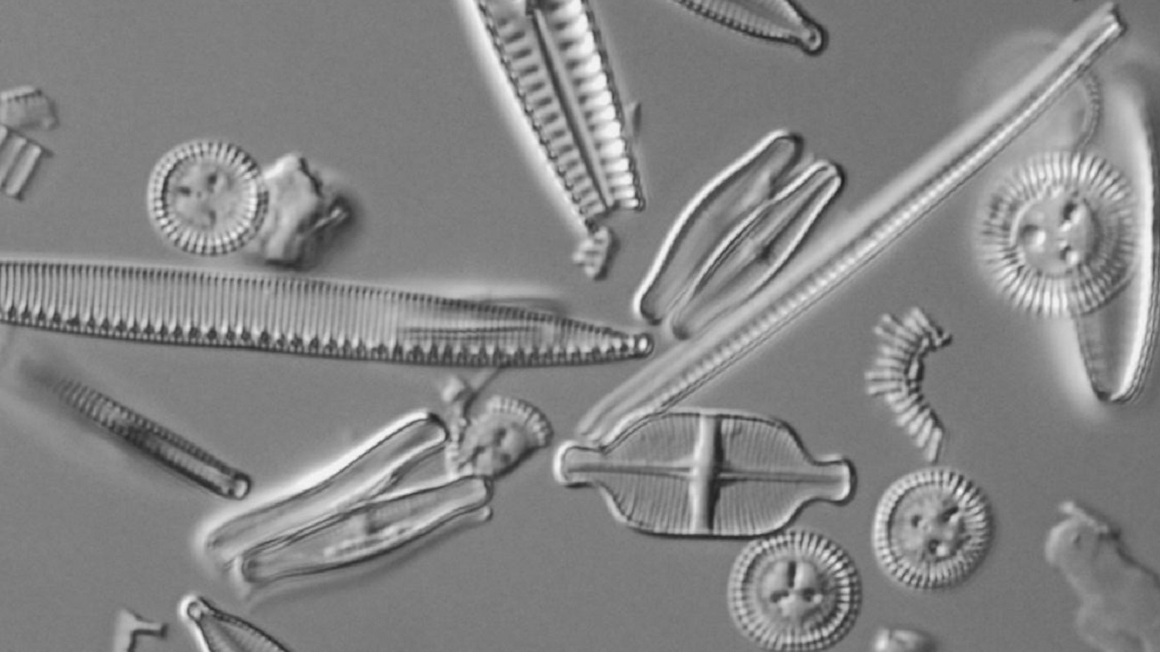What is Agri-photovoltaics?
Agri-photovoltaics, or agri-PV for short, refers to a technology that enables the combined use of agricultural land for both farming and electricity generation through photovoltaics. This approach allows for dual use of land and helps reduce competition between food production and energy generation.
Background and drivers of the technology
Germany aims to achieve climate neutrality by 2045. To meet this goal, the electricity sector is expected to operate largely free of greenhouse gas emissions by 2035. Accelerating the expansion of renewable energy is essential to reach this target, with solar energy playing a significant role in meeting climate protection objectives. According to calculations by the Fraunhofer Institute for Solar Energy Systems (ISE), photovoltaic capacity must increase by a factor of 6 to 8 to create a climate-neutral energy system by 2045.
At the same time, the global population continues to grow, driving up the demand for food and, consequently, for arable land. The expansion of ground-mounted photovoltaic systems also requires land, which can lead to increasing competition for available land resources. Additionally, agriculture already faces significant challenges due to extreme weather events and water scarcity.
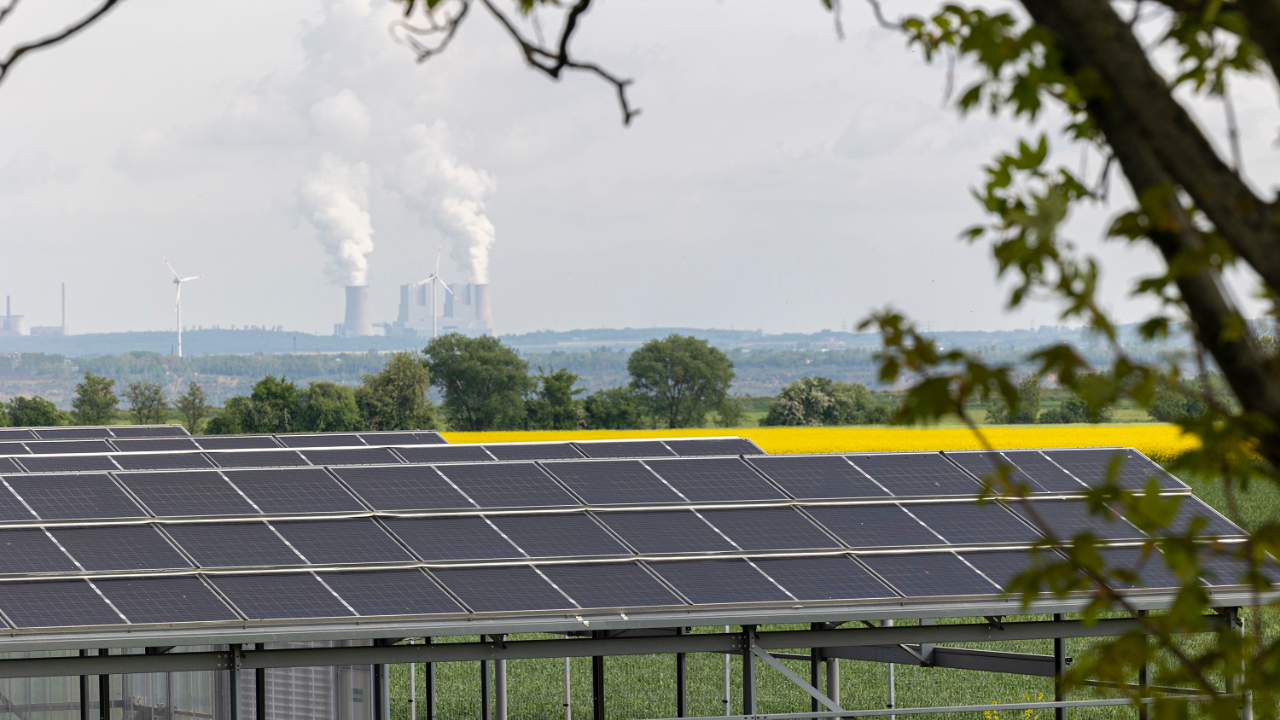
Application in the bioeconomy
Sustainable energy generation and the efficient use of biological resources are central pillars of the bioeconomy. Agri-PV combines these two aspects in an innovative way, thus promoting more sustainable agriculture. Key points on this topic were summarised by the German Federal Government's Bioeconomy Council in a background paper published in 2022.
By enabling the dual use of land for agriculture and energy production, agri-PV can reduce land-use competition, significantly increasing land-use efficiency. This is especially valuable in regions with limited arable land. From an energy production perspective, the dual use of agricultural land with agri-PV is also far more efficient than growing energy crops. For example, agri-PV can generate 32 times more electricity per hectare than energy corn. Currently, 13% of agricultural land in Germany is dedicated to energy crop cultivation.
Moreover, agri-PV can enhance the resilience of agricultural operations against the impacts of climate change. The solar modules protect crops and soil from extreme weather events and intense sunlight. More information on the benefits of agri-PV for agriculture can be found in Chapter 3.
Page 2 of 6
Agri-PV: different approaches at a glance
The technical approaches to integrating agri-PV into agriculture are diverse. Broadly, they are divided into closed and open systems.
Closed systems are essentially greenhouses equipped with PV modules. Since these are not strictly considered agri-PV, this dossier focuses on open systems.
Open agri-PV systems are either ground-mounted or elevated on frames. Ground-mounted systems allow for agricultural cultivation between the modules, are generally more cost-effective, and have less impact on the landscape. In contrast, elevated systems are more prominent but use land more efficiently and can offer crops protection from adverse environmental conditions. Agricultural use takes place beneath the modules.
There are also systems with single or dual-axis tracking. These can adjust the orientation of the modules according to the position of the sun, thus generating higher electricity yields. The choice of technology and design can be tailored to the specific requirements of the location and the crops being grown.
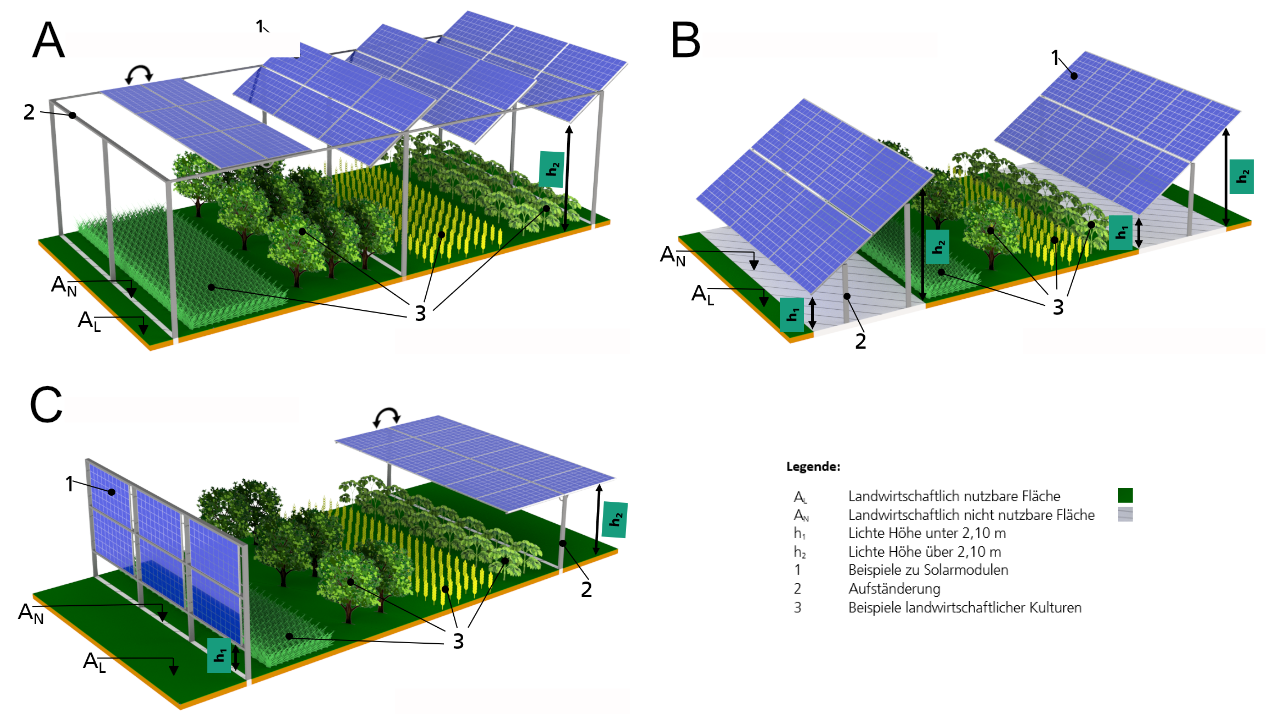
Crop selection: specialised crops with high potential
In principle, all crops can be grown and harvested under agri-PV, although the effects on yields vary. Particularly well-suited are shade-tolerant plants such as:
- Leafy vegetables,
- Forage crops,
- Various fruit and berry varieties, as well as
- Specialised crops like wild garlic, asparagus, and hops.
Agri-PV offers significant potential for synergies, particularly with specialty crops from the wine, fruit, and vegetable sectors. These crops, which often have high value per area and are very sensitive, require substantial protection. In viticulture, for example, partial shading has a positive effect on the growth and quality of the grapes and helps prevent premature ripening. Additionally, the substructure can serve as a trellis, replacing expensive protection systems.
The results of the APV-RESOLA research project in Heggelbach (more on this in Chapter 4) show that in years with high rainfall, some crops (such as potatoes, wheat, and barley) may experience yield losses. Maize, due to its high light and heat requirements, is not suitable.
Coordinating system design and crop selection
The shading of crops by PV modules creates a changed microclimate in the field. The APV-RESOLA project showed that depending on the location and system design, additional effects can occur that influence the microclimate.
The microclimate is particularly altered when the elevation of the structure is low. On hot days, soil temperature decreases, and to a lesser extent, air temperature as well. As a result, less soil water is lost in an agri-PV system. The hotter and drier the weather, the more soil moisture tends to increase. Additionally, the system's orientation and design can either reduce or increase wind speed.
A well-thought-out light and water management strategy is crucial to ensure consistent yields. Therefore, system design and crop selection must be well coordinated. The variety of PV modules offers the possibility to tailor the light levels specifically to the plants. Furthermore, increased row spacing between the modules ensures that plants receive sufficient light and rainfall.
Depending on the application, elevated systems are installed two to five meters above the field. The distances between the support structures of the substructure should be compatible with the width and height of the machinery used.
Page 3 of 6
Potential for sustainable energy generation and agriculture
Potential contribution to the energy sector
In 2023, the total electrical capacity of all grid-connected photovoltaic systems in Germany was around 82 GWp, according to Statista. The unit gigawatt peak (GWp) refers to the maximum output of photovoltaic modules under standard conditions. However, much more is needed to achieve climate neutrality as set out in the Climate Protection Act. The Fraunhofer ISE has calculated that 300 to 450 GWp of installed capacity will be required by 2045.
Among different integrated photovoltaic applications, agri-PV offers particularly large opportunities. Only around 4% of Germany's agricultural land would be needed to meet the country's entire current electricity demand with elevated agri-PV systems. In a potential assessment by Fraunhofer ISE, this corresponds to around 1,700 GW in Germany.
Climate resilience and water management
Agri-PV offers agriculture benefits that go far beyond simple electricity generation. By combining solar modules with agriculture, farmers can strengthen climate resilience on their farms while simultaneously securing their yields.
As mentioned earlier, the elevated modules of agri-PV systems act as a protective shield for crops. They shade the crops from extreme sunlight and protect them from heavy rain and hail, which are increasing due to climate change. This helps minimize yield losses from extreme weather events.
Furthermore, the shading contributes to more efficient water management. The water requirements of plants decrease, and evaporation processes are reduced. Rainwater running off the modules can be collected in harvesting systems and used for irrigation.
Stable Sources of Income and Decentralised Energy Supply
In addition, agri-PV allows farmers to diversify their income. The self-generated solar power can, for example, be used on the farm for processing and packaging agricultural products or fed into the power grid. This strengthens the financial independence of the farms.
Especially in sun-rich (semi)arid regions of the world, agri-PV offers enormous advantages. The electricity generation can be used for water treatment and supply, countering desertification and soil degradation. This makes it possible to grow crops that otherwise cannot be cultivated in these climatic zones.
Page 4 of 6
Science Meets Practice: Research Projects and Demonstration Plants
According to the agri-PV guide created by Fraunhofer ISE in Freiburg, at least eleven agri-PV pilot plants were operational in Germany by 2023. The following section presents some publicly funded research projects and demonstration plants.
APV-RESOLA
The pilot plant in Heggelbach on Lake Constance, built as part of the BMBF-funded research project Agrophotovoltaics: Contribution to Resource-Efficient Land Use, serves as an impressive example of the potential of agri-PV.
Under the leadership of Fraunhofer ISE, the technical, economic, social, and ecological feasibility of agri-PV was researched. The project partners include the University of Hohenheim and the Institute for Technology Assessment and Systems Analysis (ITAS) at the Karlsruhe Institute of Technology. The system, consisting of 720 bifacial double-glass PV modules with a total capacity of 194 kWp, is elevated five meters high and provides ample space for growing various crops such as winter wheat, potatoes, celery, and clover.
Land Use Efficiency
To assess the efficiency of dual land use, the Land Use Rate (Landnutzungsrate: LNR) is often used. It compares the combined outputs of an agri-PV system (electricity and biomass) with the outputs that would be achieved from pure agricultural use or a ground-mounted PV system. An LNR of 1.5 indicates that one hectare of agri-PV produces the same amount of electricity and yield as 1.5 hectares of purely agricultural land or PV use. The LNR only measures land use efficiency and does not provide any information about economic viability.
In the first project year of 2017, the agri-PV system was able to demonstrate its performance. The Land Use Rate (LNR) increased by up to 160%, while the crop yields under the modules remained above the critical 80% mark compared to the reference area without photovoltaic (PV) modules.
Another advantage of the agri-PV technology became apparent during the hot summer of 2018. The shading from the modules had a positive impact on crop yields, particularly for potatoes, where land use efficiency increased by 86%. The plants were likely able to better compensate for the lack of rainfall due to the additional shading. The APV-RESOLA project was successfully completed in 2021.
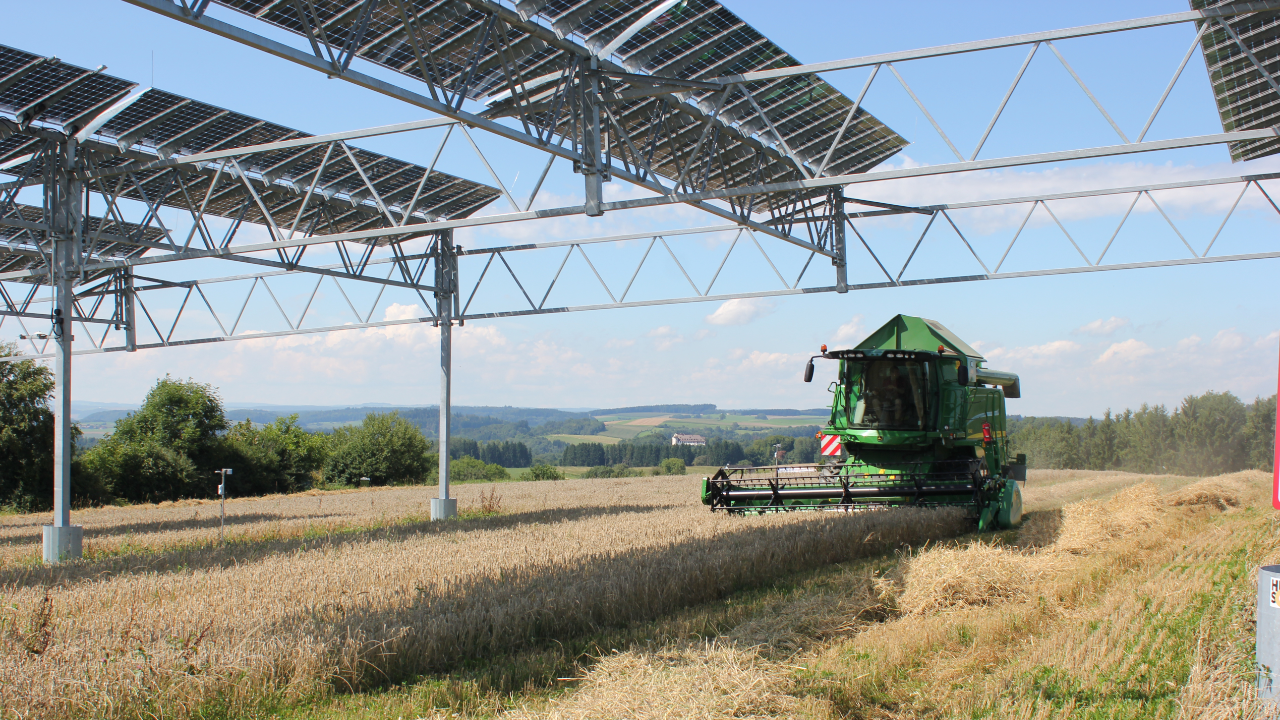
Agri Food-Energy-Park (AgriFEe) Innovation Lab
As part of the Bioeconomy model region in the Rhineland mining area, the Agri Food-Energy-Park (AgriFEe) innovation lab was established under the leadership of the Forschungszentrum Jülich. The demonstration plant in Morschenich-Alt spans approximately two hectares, where various high-value plants such as berry bushes, as well as medicinal and aromatic plants, are cultivated under around a thousand PV modules. Researchers aim to identify suitable crops for different PV systems and develop software that can calculate the optimal spacing between modules for efficient shading. Additionally, plant growth under the PV systems is continuously monitored using a self-developed probe. Rainwater collection systems and smart irrigation strategies are also being developed.
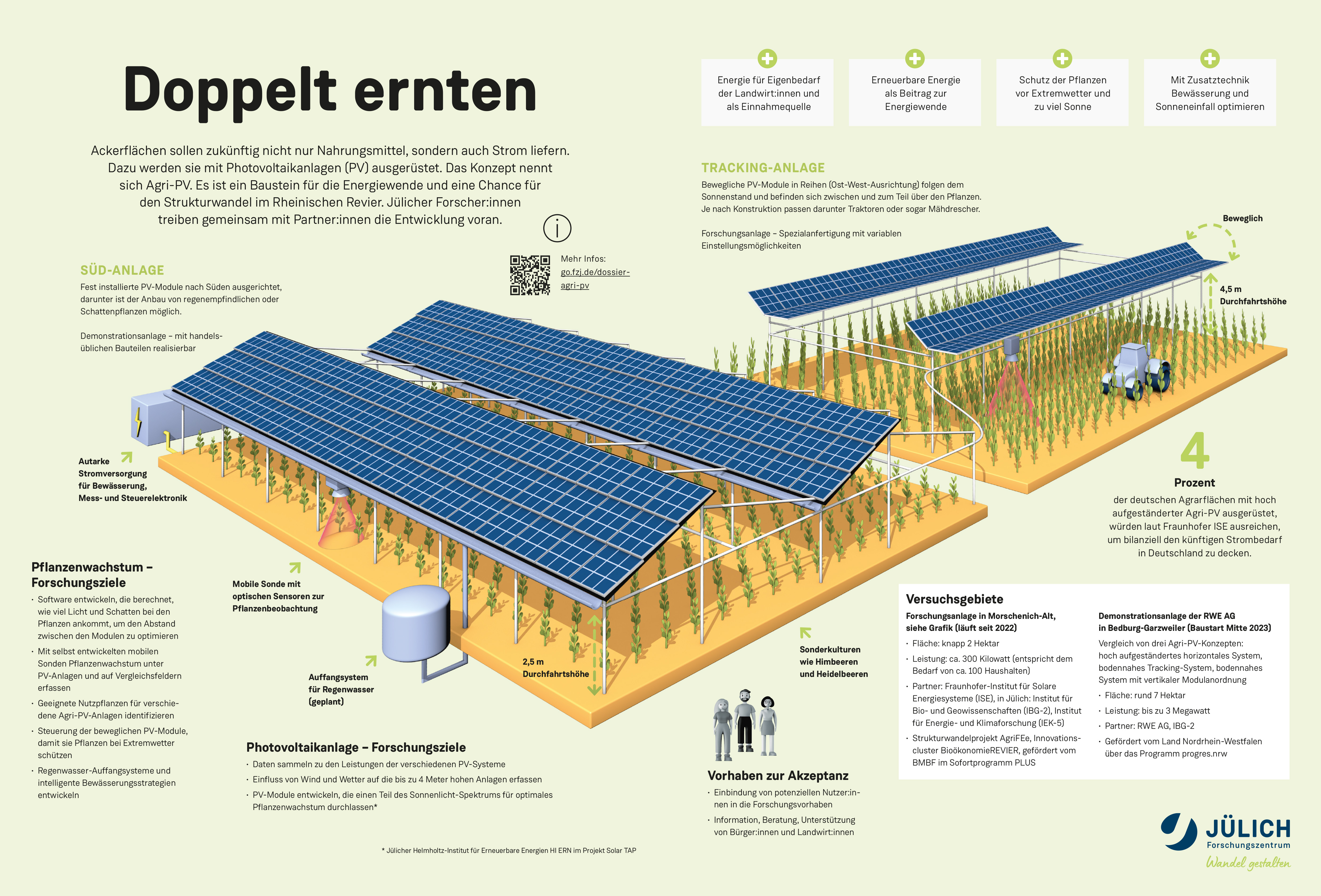
SynAgri-PV
The research project "SynAgri-PV: Synergistic integration of photovoltaics in agriculture as a contribution to a successful energy transition – Networking and support for the market ramp-up of agri-PV in Germany" has the overarching goal of describing and evaluating the key technical, legal, economic, and social conditions for the establishment of agri-PV in the German market, as well as developing proposals for its widespread adoption.
Funded by the BMBF and coordinated by Fraunhofer ISE, nine partners from research, practice, and industry are working together to develop a roadmap for the deployment of agri-PV in Germany. Participants include, among others, the Leibniz Centre for Agricultural Landscape Research (ZALF) and the University of Hohenheim.
As part of this project, several agri-PV utilization concepts have also been integrated into the digital agricultural landscape laboratory „digi.farming.lab“. The well-known computer game "Farming Simulator" is used on the virtual platform to make research topics tangible in 3D. In total, four best-practice examples of agri-PV systems have been integrated.
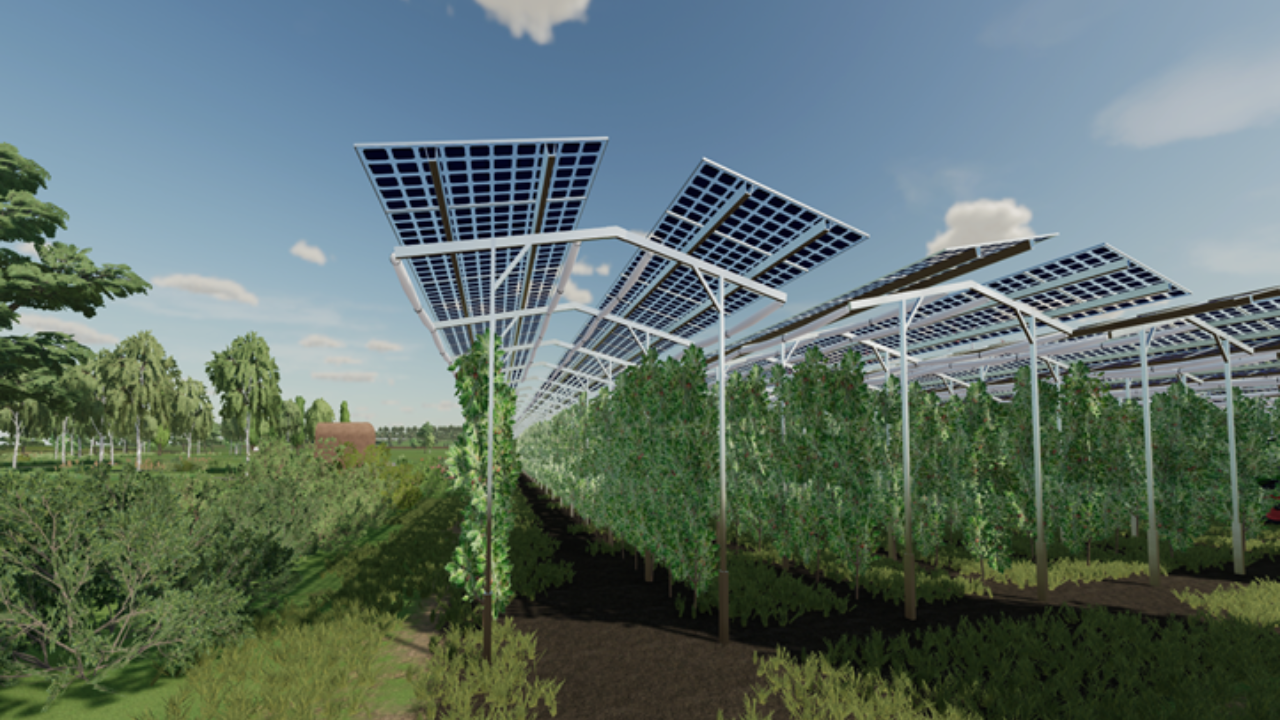
APV Fruit Cultivation
The project "APV Fruit Cultivation," funded by the Federal Ministry of Food and Agriculture (BMEL), investigates agri-PV in apple cultivation to increase resilience and use land more efficiently. The system replaces protective structures such as hail nets and utilizes the generated energy in apple production. The facility in Gelsdorf, Rhineland, analyzes the concept under real conditions and examines different apple varieties. A guide for fruit-growing businesses is being developed, and the integration into the climate protection plan is being evaluated.
VAckerPower
The research projects "VAckerPower," funded by the Federal Ministry for Economic Affairs and Climate Action (BMWK), and "VAckerBio," funded by the German Federal Environmental Foundation (DBU), investigate vertical agri-PV systems in arable farming. "VAckerPower" analyses elevated and ground-level systems, as well as various PV modules, in terms of performance, sustainability, and acceptance. Life cycle assessments and strategies to improve the technology are being developed.
Model region Agri-PV BaWü
Baden-Württemberg is funding the establishment of five agri-PV systems as part of the "Model Region Agri-PV BaWü" project. The first phase focuses on core and berry fruits. Various types of PV modules are being tested, and plant growth under the PV modules is being analysed. Additionally, a project website informs the public and farmers about the process of setting up an agri-PV system.
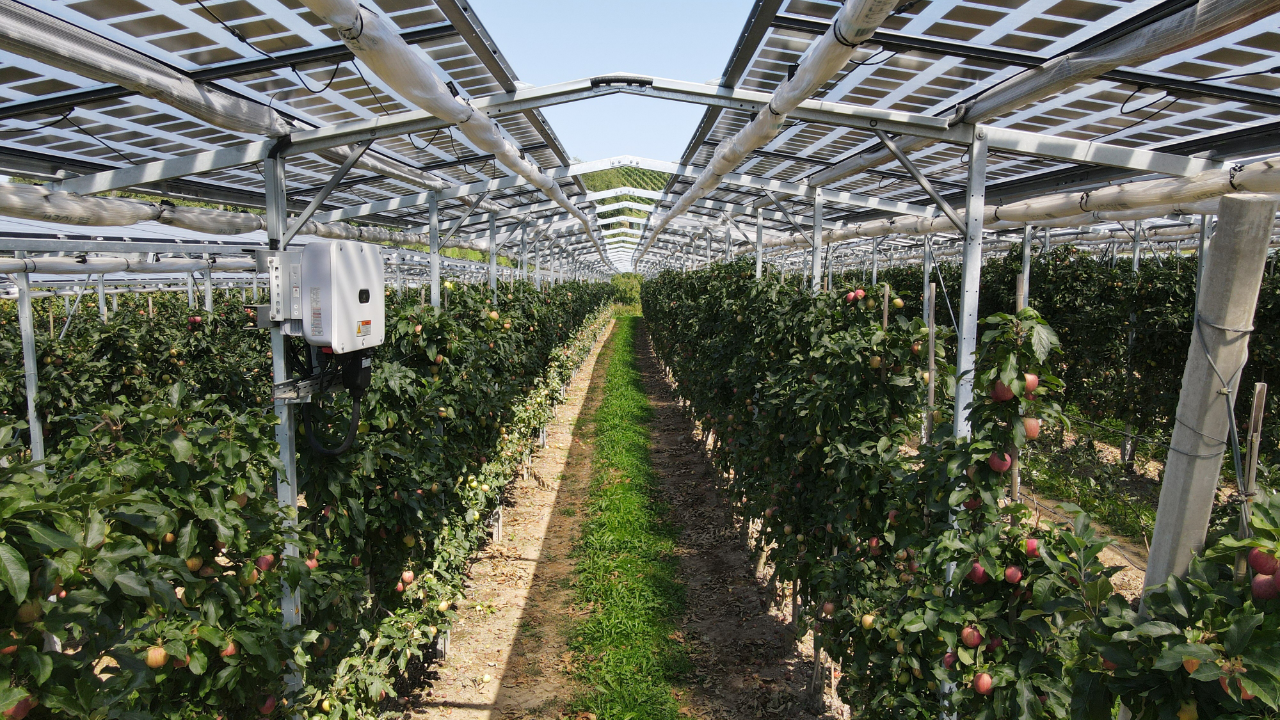
VitiVoltaic and VitiCult-PVmobil
Geisenheim University, in cooperation with Sbp Sonne and Fraunhofer ISE, has developed two innovative types of agri-PV systems for grapevines. Since March 2023, the "VitiVoltaic" project has been testing an agri-PV system with movable, semi-transparent modules. Since June 2024, the "VitiCult-PVmobil" project has been investigating a prototype of a mobile, extendable agri-PV system for new vine plantings.
International research activities on agri-PV
- Chile: In collaboration with Fraunhofer Chile, the first agri-PV pilot systems in Latin America were established, with positive results driving further expansion of the technology. A policy brief was also published, highlighting opportunities, challenges, and policy recommendations for agri-PV in Chile.
- Brazil: In Minas Gerais, Brazil, agri-PV pilot systems have been installed in a region with a semi-arid climate and high solar radiation. The goal is to examine the technical and economic feasibility of agri-PV in the local context.
- USA: In several states across the USA, agri-PV systems are focusing on biodiversity. Researchers are working to make agri-PV, in combination with agricultural use, more economically attractive.
- Mali and Gambia: An international consortium from Mali, Gambia, and Germany researched in the "APV-MaGa" project how agri-PV with integrated rainwater harvesting can contribute to greater resilience in agriculture.
- Turkey: The "SusMedHouse" project aims to improve the productivity, efficiency, and sustainability of greenhouses in the Mediterranean region. One component of the project is the use of agri-PV to protect plants and generate electricity.
We thank the agri-PV experts Frederik Schöneberger from Fraunhofer Chile and Moritz Gajewski from Fraunhofer ISE for their excellent communication and for providing valuable information.
Page 5 of 6
On the way to market maturity
The expansion of agri-PV in Germany is still in its infancy. To address the challenges of developing agri-PV towards market maturity, political, economic, and societal aspects must be considered.
The role of politics
Farmers have repeatedly criticized the legal framework for agri-PV, particularly the complex approval processes and inadequate subsidies. The German government's Solar Package I tackles some of these issues, with changes to the Renewable Energy Sources Act (EEG) aimed at accelerating the expansion of photovoltaic systems.
The EEG 2023 specifically supports agri-PV systems on various agricultural lands, including arable land, crop land, and grassland. Arable agri-PV refers to photovoltaic systems on arable land while simultaneously cultivating crops, whereas crop agri-PV applies to systems on land with perennial or permanent crops. Grassland agri-PV includes systems on permanent grasslands, as long as these areas are not located in Natura 2000 areas.
Higher funding rate and a separate category for agri-PV
With the passage of Solar Package I in May 2024, the EEG will be further developed and better adapted to the needs of agri-PV. A central point of the Solar Package is the increased funding for agri-PV and other special solar systems, such as floating, peat, and parking lot installations. A separate subcategory with a maximum rate of 9.5 cents per kWh will be introduced for these systems. As a result, agri-PV will be more generously compensated than ground-mounted PV systems. This measure aims to help agri-PV move beyond its current niche role.
Additional bonuses for extensively managed systems
The expansion of photovoltaic systems on agricultural land is limited to 80 gigawatts by 2030. Special, extensively managed agri-PV systems will receive a bonus if they meet criteria such as herbicide-free farming. These political measures are intended to increase the incentive for farmers to invest in agri-PV, contributing to the sustainability and profitability of agriculture.
Agricultural perspectives – profitability and acceptance
Whether investing in an agri-PV system is worthwhile for farmers depends, in addition to the legal framework, on several other factors and requires a thorough evaluation. Key factors for success include investment and operating costs, crop and electricity yields, as well as the individual operating conditions.
Agri-PV systems are generally more expensive than ground-mounted systems, as the substructure is more complex, and the PV modules are often custom-made. Additionally, higher costs for repairs and cleaning are involved. It is also important to consider the change in the microclimate caused by the elevation of the system, as discussed in Chapter 2, which can affect yields. Moreover, as the module density increases, light availability for plants decreases, which may lead to losses. Depending on the design and management of the system, the agricultural land area available for farming is reduced by 10 to 15%. However, savings in land maintenance can be expected from utilising the space beneath the modules.
Electricity from an agri-PV plant is usually most profitable when used for self-consumption, thus reducing the need for external electricity. Additional income is generated by feeding surplus electricity into the grid, depending on the current feed-in tariff.
In summary, agri-PV can be a profitable investment for farmers, but it requires careful planning and adaptation to individual circumstances. Profitability varies depending on crop selection, location, and system design. Nevertheless, the dual use of land can create stable income sources for agricultural businesses and enhance resilience against crop failures.
Involving the public
In addition to the profitability of agri-PV systems, societal acceptance can also pose a challenge to the expansion of the technology. A key conflict is the impact of agri-PV on the landscape and the associated opposition from local residents. It is therefore essential to inform the public and stakeholders early on and involve them in the planning process of an agri-PV system.
The APV-RESOLA project gathered public opinion on agri-PV and identified barriers and success factors through a multi-stage participatory process, including information events, citizen workshops, and focus groups. The respondents supported the energy transition but expressed concerns about the impact of agri-PV on the landscape and agriculture. They called for criteria-based site selection, early citizen involvement, and consideration of nature conservation.
Agro-ecological perspectives
Agri-PV impacts the environment, so potential effects on flora and fauna should be considered. There is evidence that agri-PV can positively influence biodiversity if the systems are managed extensively.
Extensive agri-PV systems are ground-mounted PV installations on agricultural land that, through their design and land management, demonstrably promote biodiversity. For example, these systems may have wide sunlit strips, homogeneous water distribution via drip edges between modules, and a more biodiversity-oriented use, such as insect-friendly mowing and the avoidance of fertilisers and pesticides.
In the case of livestock farming under agri-PV, shading can help alleviate heat stress for the animals. Research projects on the environmental impact of agri-PV remain crucial to ensuring that the technology can be used sustainably.
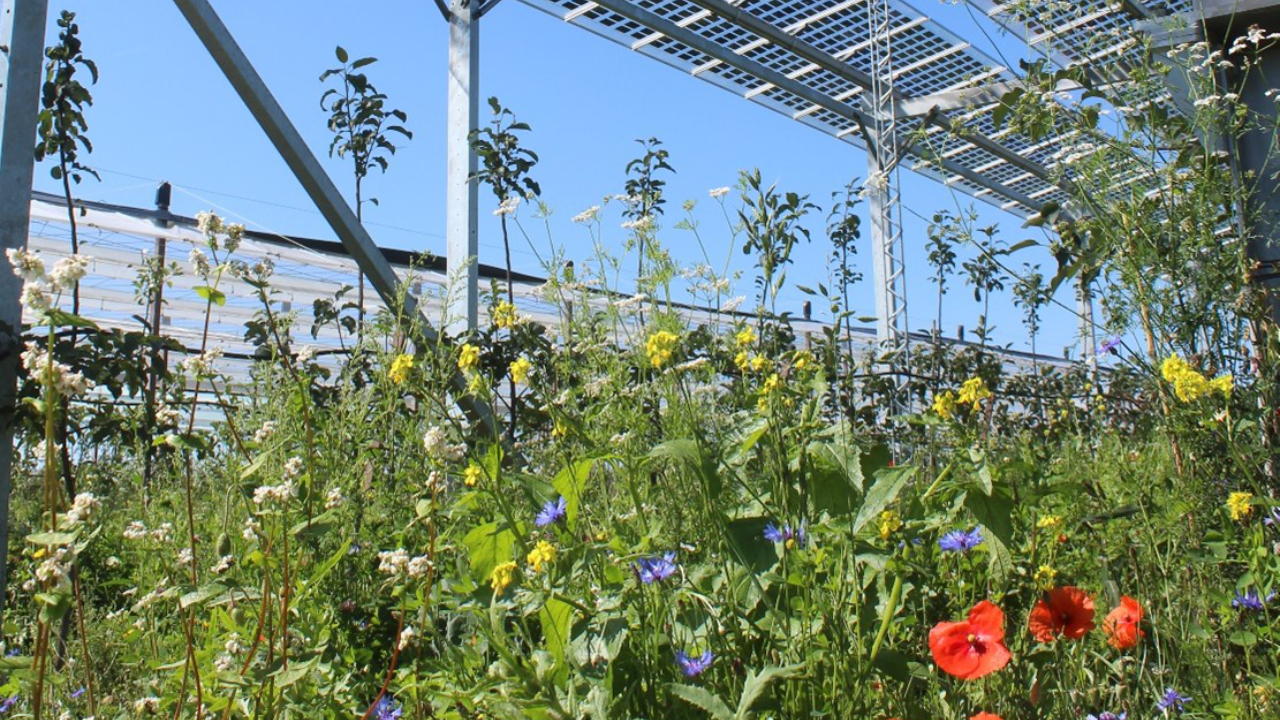
Page 6 of 6
Further information and sources
Further information and sources
Agri-Photovoltaik: Chance für Landwirtschaft und Energiewende; Ein Leitfaden für Deutschland. Edited by: Fraunhofer ISE im Auftrag des BMBF (2024): PDF-Download
Hintergrundpapier Agri-Photovoltaik (Agri-PV): Edited by: Bioökonomierat (2022): PDF-Download
More on bioökonomie.de
News: With agri-voltaics to sustainable fruit cultivation (English)
News: Apple trees under solar panels (English)
News: Agri-PV kann Dürrefolgen ausbremsen (German)
News: Agri-PV marktfähig machen (German)


